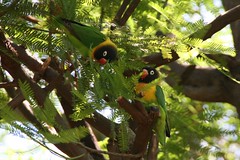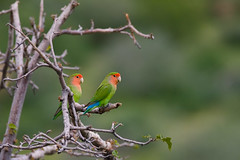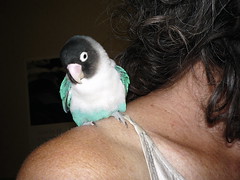
STOMPer Vanillaijs and her husband were pleasantly surprised when they spotted this pretty bird flying around in their Buangkok flat on Sunday (April 12).
In an email to STOMP yesterday (April 14), the STOMPer said:
"My husband and I were woken on Sunday afternoon by some commotion. Our dogs were banging lightly on our glass room. We were pleasantly surprised to see a pretty, colorful bird cruising around in our house.
"It didn't seem to be afraid of us at all.
"It even came really close to us and stayed there. We spoke to it and it even nodded its head and looked as if it was responding to what we said.
"Even when we put a big zip lock bag over it, it did not struggle at all. We later placed the bird on the balcony as we thought that it might be hurt or couldn't find its way out because of our glass partition.
"It happily checked out our balcony garden before leaving much later.
"Anyone knows what kind of bird it is?”"
STOMP is contacting Jurong Bird Park to find out what kind of bird it is.
It looks like the visitor is a Fischer's lovebird (Agapornis fischeri). This is a small African parrot native to a small area of northern Tanzania.

Fischer's lovebirds, Tanzania;
(Photo by mpgoodey)
Like other small parrot species such as budgerigars (Melopsittacus undulatus) and cockatiels (Nymphicus hollandicus), lovebirds are highly popular as pets. The 9 species of the genus Agapornis are found in various parts of tropical Africa and Madagascar, and besides the Fischer's lovebird, 2 other lovebird species commonly seen in the pet trade are the masked lovebird (Agapornis personatus) and peach-faced lovebird (Agapornis roseicollis).


Left: Masked lovebird;
(Photo by c-eight)
Right: Peach-faced lovebird;
(Photo by PeregrinesBirdBlog)
In the past, many more species were widely available as pets, and little effort was put into breeding them in captivity. As such, species such as the grey-headed lovebird (Agapornis canus), red-faced lovebird (Agapornis pullarius) and black-cheeked lovebird (Agapornis nigrigenis) are now rare in captivity, although they used to be imported in great numbers.
Although all lovebird species are not considered to be seriously endangered, heavy trapping for the pet trade remains a significant threat to wild populations, even though the 3 lovebird species commonly kept as pets are now usually captive bred. Selective breeding has also led to several colour mutations being available in the trade. This Wikipedia entry discusses the finer details of how the colour of the peach-faced lovebird's plumage is affected by genetics.


Two lovebird colour mutations.
Left: Masked lovebird ("blue");
(Photo by Catzz1)
Right: Peach-faced lovebird ("lutino");
(Photo by EastBayAnt)
The peach-faced lovebird has been encountered in Singapore as an escapee, although the individual sighted might have been deliberately released. We can now add the Fischer's lovebird to a growing list of free-flying parrot species spotted in Singapore over the decades.